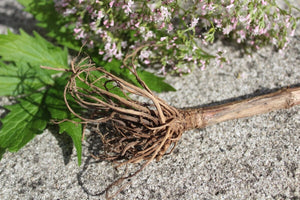Crucial Steps You Need to Know for Tomato Blight Prevention and Control
DiseasesThere’s probably nothing that strikes fear in a gardener more than the term tomato blight. This fungal menace can swiftly devastate a tomato crop, leaving gardeners with withered plants instead of juicy fruits. While blight is caused by fungal spores and weather conditions we can’t control, there are ways to limit its spread. We’ll explain the difference between early and late blight and what you can do to create a more blight-resistant garden.

What is Tomato Blight?
Tomato blight refers to a group of fungal diseases known to attack tomato plants. These diseases can devastate not only tomato crops but also potato tubers, as the pathogens involved often affect both plant species. Several factors contribute to the development and spread of tomato blight, with the type of pathogen, environmental conditions, and plant health all playing significant roles.
The impact on the plant is multifaceted. Not only does the disease stress the tomato plant by attacking its foliage, which reduces the plant's ability to photosynthesize, but it can also directly affect the fruit. Infected tomatoes develop dark, sunken areas, making them inedible. Moreover, the pathogens can remain in the soil and plant debris, leading to reinfection in subsequent growing seasons if not properly managed.

Causes of Tomato Blight
The primary cause of tomato blight is the presence of fungal spores. These spores can survive in the soil or on infected plant debris, lying dormant until the right conditions trigger their activation and subsequent infection. Fungal diseases causing blight include, but are not limited to, Phytophthora infestans and Alternaria solani, the causative agents of late blight and early blight, respectively.
For these spores to grow, they need the right conditions. The conditions for blight to thrive are moisture, temperature, pH, and a host plant.
Early Blight vs Late Blight
As the names suggest, early and late blight attack tomato plants at different times in the growing season. However, they aren’t limited to those times. Different blights appear based on the prevalence of spores and the environmental conditions.
Early blight generally appears in the early growing season. It affects the plant from the base upwards, causing brown lesions with concentric rings. Weather conditions are the main culprit of early blight, which is more preventable than late blight.
Late blight, on the other hand, attacks tomato plants later in the growing season. It starts on the leaves, creating irregularly shaped dark spots, and can rapidly spread to the entire plant under humid conditions. Because of its ability to spread quickly, regular monitoring of weather conditions and plant stress is crucial.
How to Prevent Early Blight
The pathogens for early blight are already in the soil. When conditions are favorable, spores will grow and spread. Early blight attacks tomato plants when the weather is still cool and moist. Dark spots will first appear on foliage near the ground. These brown spots will grow, forming concentric rings. Early blight can kill tomato seedlings.
To help prevent early blight, don’t transplant your tomatoes too early. Cold nights in the 40s can lead to heavier dew. Wait for night temperatures to be at least 50ºF.
Once tomato plants are in the ground, the first step to preventing early blight is to keep leaves off the soil. You can use fabric barriers or mulch to keep pathogens from splashing up onto the leaves.
The next step is to use effective watering methods, such as drip irrigation, to avoid splashing infected soil onto plants.
Then, use trellises or tomato cages to keep plants upright and allow for sufficient airflow. Pruning your tomato plants will keep leaves off the ground and provide adequate airflow.
Remove any leaves or fruit with signs of blight and burn them or throw them in the garbage. Avoid working with plants when they are wet, and sanitize pruning tools to avoid spreading any spores.

Late Blight on Tomatoes
Late blight is caused by the water mold Phytophthora infestans. This pathogen thrives in wet weather and can quickly devastate entire crops. It is the same pathogen that resulted in the Irish Potato Famine.
A late blight infection shows up as dark spots on leaves and brown lesions on stems. These lesions can lead to the rapid collapse of the entire plant. The tomato fruit can also develop brown spots that render it unpalatable and unsuitable for eating.
Late blight spreads through spores that can be carried across long distances by the wind, meaning that even remote gardens can become infected from neighboring areas. Signs of blight on tomatoes need to be identified quickly, as the disease can progress rapidly, potentially destroying crops within days under the right weather conditions. Late blight is considered one of the most severe plant diseases due to its highly infectious nature and potential for widespread damage to both tomato and potato crops.
How to Prevent Late Blight
Late blight can be harder to prevent because of weather conditions that are out of our control. However, you can limit the spread of late blight by focusing on keeping foliage dry, promoting good air circulation, and maintaining garden sanitation.
Other Blights That Affect Tomatoes
Septoria Leaf Spot
The fungus Septoria lycopersici causes Septoria Blight or Septoria Leaf Spot. This blight can affect tomatoes at any stage of development. It first appears as tiny brown spots on the lower leaves, but it can also attack the rest of the plant. The steps to control Septoria leaf spot are the same as those for other tomato blights.
Botrytis Blight
This gray-looking fungus is caused by high humidity and moisture with temperatures between 65 and 73ºF.
The spores can remain dormant and then start reproducing when a plant has been stressed. To get rid of botrytis blight, give plants enough space for adequate airflow and use good garden sanitation practices.
Sources:

Symptoms of Tomato Blight
To correctly manage and tackle tomato blight, it is essential to recognize the symptoms early. The most common indications are discolored patches that can appear on any part of the plant. Here are key symptoms gardeners should be alert for:
Early Stages of Tomato Blight:
Small, dark spots on leaves, which may have a concentric ring pattern.
Leaves turning yellow, wilting, or showing signs of decay.

Advanced Stages of Tomato Blight:
Growth of brown lesions with a greasy appearance.
Stems becoming brown and brittle, leading to plant collapse.
Tomato fruit developing dark, sunken spots, often starting at the blossom end.
Regularly inspect your tomato plants, especially when there have been wet weather conditions. By spotting these symptoms in their early stages, you can take appropriate action to mitigate the spread and severity of the disease.

How to Manage Tomato Blight
Once you identify blight on your tomato plants, can you do anything to keep it from spreading? There are things you can do to manage blight and preserve your tomato plants. These wise gardening practices will help to keep your tomato plants healthy.
1 - Prune Blight Infected Parts:
Remove and dispose of any infected plant parts, such as leaves, stems, or fruits, as soon as you notice them. This helps prevent the spread of the disease to healthy parts of the plant and to other plants.
2 - Improve Air Circulation:
Blight thrives in warm, humid environments with poor air circulation. Increase airflow around your plants by spacing them appropriately and avoiding overcrowding. You can also prune nearby vegetation to improve airflow.
3 - Water Wisely:
Avoid overhead watering, which can promote the spread of fungal diseases like blight. Instead, water your plants at the base to keep the foliage dry. Water in the morning to allow any moisture on the leaves to evaporate during the day.
4 - Practice Crop Rotation:
If blight is a recurring problem in your garden, consider rotating your crops each season. This helps disrupt the life cycle of pathogens in the soil and reduces the risk of reinfection.
5 - Use Disease-Resistant Varieties:
When planning your garden, select plant varieties known to be resistant to blight or other common diseases in your area. This can help minimize the risk of blight affecting your plants.
6 - Monitor Regularly:
Keep a close eye on your plants throughout the growing season for any signs of blight or other diseases. Early detection allows for prompt action, which can help prevent the spread of the disease.
7 - Practice Good Garden Hygiene:
Clean up garden debris regularly to reduce the presence of pathogens and overwintering sites. Sanitize gardening tools between uses to prevent the spread of disease from one plant to another.
8 - Fertilize Appropriately:
Use a balanced fertilizer for perennials and appropriate fertilizer at the right time for tomatoes.
9 - Apply Fungicides:
As a last resort in severe cases or when preventive measures aren't sufficient, you may need to use fungicides to control blight. Choose a fungicide labeled for the specific type of blight affecting your plants, and follow the instructions carefully.
Growing healthy plants that give you a delicious harvest is the payoff we gardeners always strive for. That’s why tomato blight is so frustrating. It can appear anytime during the growing season and wipe out all your efforts. However, using time-tested gardening methods can help control the spread of disease. Implement these wise gardening practices, and you’ll have healthy plants that can withstand the pressures of pests and diseases.
Popular Posts
-

Top 20 Deer Resistant Perennial Flowers to Keep Your Garden Beautiful and Safe
-

How to Grow Valerian Root from Seed to Harvest






Leave a comment